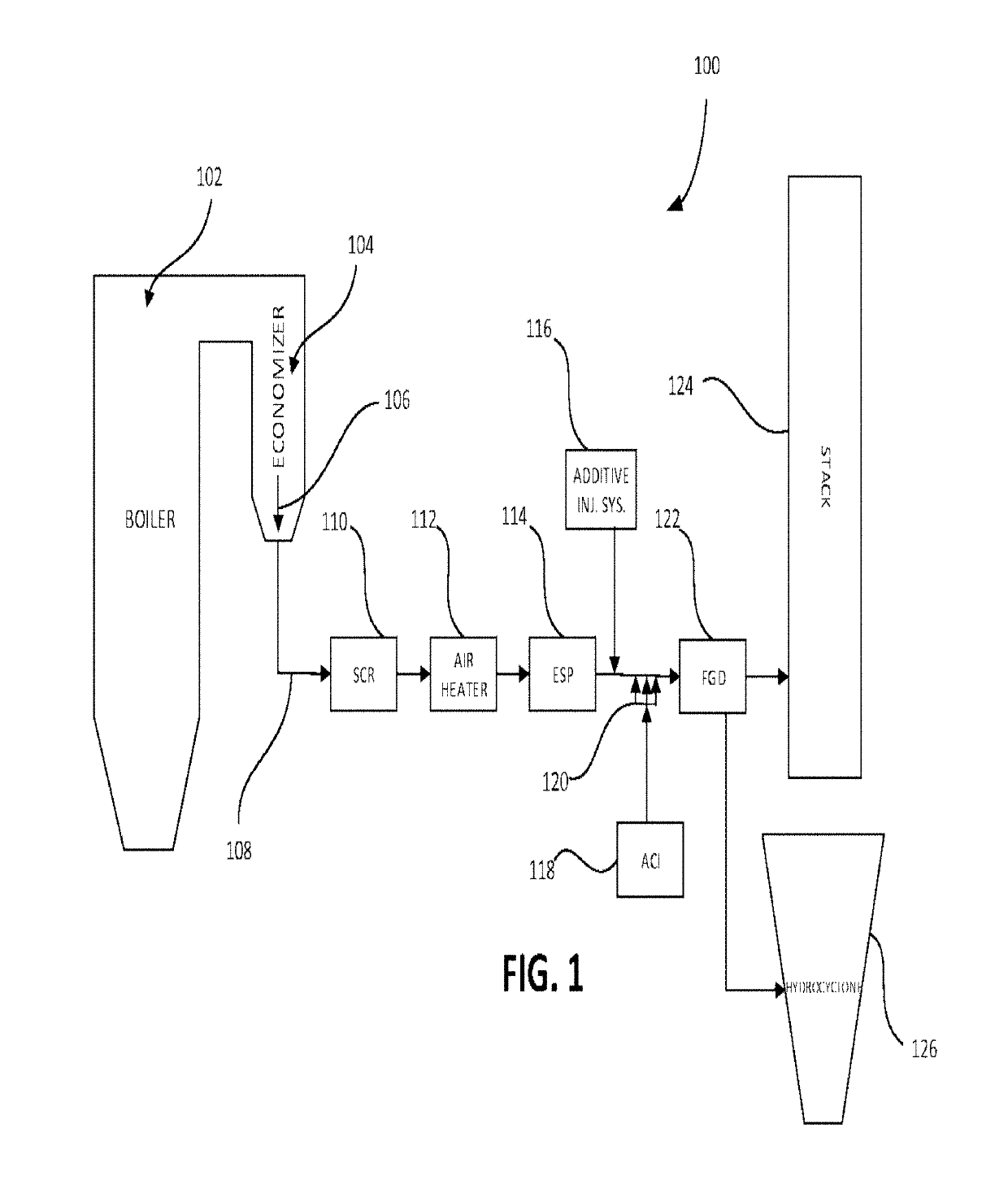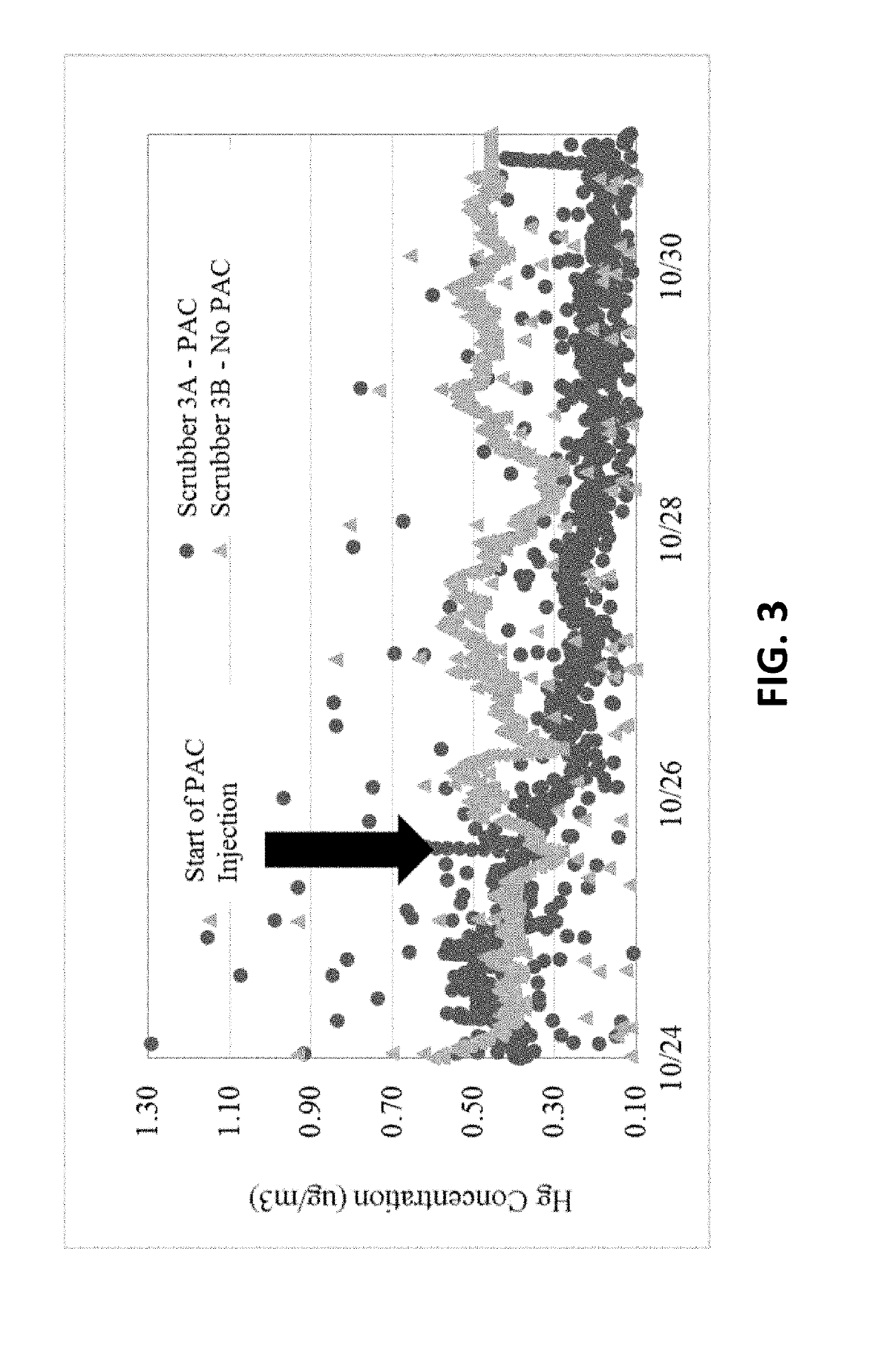Systems and methods for post combustion mercury control using sorbent injection and wet scrubbing
a technology of sorbent injection and wet scrubbing, which is applied in the direction of dispersed particle separation, other chemical processes, separation processes, etc., can solve the problems of affecting the environment, and reducing the service life of sorbents, so as to improve the service life and improve the effect of mercury removal
- Summary
- Abstract
- Description
- Claims
- Application Information
AI Technical Summary
Benefits of technology
Problems solved by technology
Method used
Image
Examples
example 1
on of PAC
[0051]A magnetic activated carbon sample with 6% by weight of magnetite (Fe3O4) was prepared with PAC treated with a wet method to precipitate ferric chloride and ferrous sulfate in 200 lb. batches followed by dewatering and drying at 200° C. The dried product was sieved and resulted in about 95% of the final product passing through a 325-mesh sieve.
Mercury Removal
[0052]The product was tested at the Mercury Research Center (MRC). The MRC removes a constant flow of approximately 20,500 actual cubic feet per minute (acfm) of flue gas (representative of a 5 mega watt [MW] boiler) from the Southern Company Plant Christ Boiler (78 MW). The boiler runs on a low-sulfur bituminous coal blend from varying sources. The typical SO3 concentration of the fuel blends resulted in about 2 parts per million (ppm) of SO3. FIG. 2 shows improved mercury capture when using an embodiment of an Improved Sorbent Injection System. The product was pneumatically injected at increasing injection rates...
example 2
on of PAC
[0053]A coal-fired power plant with a 540 MW unit was conducting a trial to inject a powdered sorbent into the wet scrubber sump which was subsequently pumped into the absorber vessel. The powdered sorbent met the typical 95% passing the 325 mesh with a d50 particle size of 15 microns. Albeit vapor phase mercury emissions went down based on continuous emissions monitoring equipment, the unit began experiencing elevated levels of mercury in their sorbent traps. This was because Hg bound to the fine PAC particles was escaping past the mist eliminators and being captured in the sorbent trap. Furthermore, the fine PAC particles began clogging the rotary vacuum filters, causing the system to shut down.
[0054]In a second trial of the Improved Sorbent Injection System, a powdered sorbent with 50% passing the 325 mesh and a d50 particle size of 45 microns was added to the sump and subsequently injected into the absorber.
[0055]Turning now to FIG. 3, data shows the improved mercury ca...
example 3
[0056]A coal-fired power plant with a 700 MW unit conducted a trial of the Improved Sorbent Injection System where a sorbent composition of 83% activated carbon with a d50 of 45 microns was admixed with 15% magnetite (as a catalyst) and 2% potassium permanganate (as oxidant). The sorbent composition was injected into the recirculating liquor of the wet flue gas desulfurization unit at 5 pounds per hour. FIG. 4 shows a flowchart of a process for controlling mercury from process gas according to an embodiment of this disclosure. The data in FIG. 5 show the improved air-phase mercury capture when using an embodiment of the Improved Sorbent Injection System. The Improved Sorbent Injection System was able to reduce air-phase mercury emissions without the use of halogens. FIG. 6 shows data indicating the improved aqueous-phase mercury capture when using an embodiment of the Improved Sorbent Injection System. Turning now to FIG. 7, the data show improved control of scrubber chemistry when ...
PUM
| Property | Measurement | Unit |
|---|---|---|
| particle size | aaaaa | aaaaa |
| particle size distribution | aaaaa | aaaaa |
| particle size | aaaaa | aaaaa |
Abstract
Description
Claims
Application Information
 Login to View More
Login to View More - R&D
- Intellectual Property
- Life Sciences
- Materials
- Tech Scout
- Unparalleled Data Quality
- Higher Quality Content
- 60% Fewer Hallucinations
Browse by: Latest US Patents, China's latest patents, Technical Efficacy Thesaurus, Application Domain, Technology Topic, Popular Technical Reports.
© 2025 PatSnap. All rights reserved.Legal|Privacy policy|Modern Slavery Act Transparency Statement|Sitemap|About US| Contact US: help@patsnap.com



